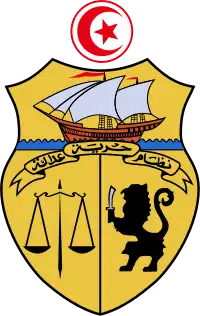1989 Tunisian general election
General elections were held in Tunisia on 2 April 1989. It was the first time presidential elections had been held since 1974, as Habib Bourguiba had been declared President-for-life the following year. However, his replacement, Zine El Abidine Ben Ali, was the only candidate to obtain endorsements from 30 political figures, as required by the Constitution. As a result, he was unopposed for a full term.[1]
 |
|---|
| This article is part of a series on the politics and government of Tunisia |
|
|
|
|
In the Chamber of Deputies election, the Constitutional Democratic Rally (a renamed Socialist Destourian Party) won 80.6 percent of the vote and all 141 seats. According to official figures, voter turnout was 76.5% in the parliamentary election and 76.1% in the presidential election.[2]
Results
President
| Candidates | Parties | Votes | % | |
|---|---|---|---|---|
| Zine El Abidine Ben Ali | Constitutional Democratic Rally | 2,087,028 | 100 | |
| Blank or invalid votes | 15,348 | - | ||
| Total | 2,102,351 | 100.00 | ||
Chamber of Deputies
| Parties | Votes | % | Seats | +/– | |
|---|---|---|---|---|---|
| Constitutional Democratic Rally | 1,633,004 | 80.6 | 141 | +16 | |
| Movement of Socialist Democrats | 76,250 | 3.8 | - | new | |
| Party of People's Unity | 13,596 | 0.7 | - | new | |
| Unionist Democratic Union | 7,912 | 0.4 | - | new | |
| Leftist Coalition | 7,619 | 0.3 | - | new | |
| Progressive Socialist Party | 5,720 | 0.4 | - | new | |
| Social Party for Progress | 5,270 | 0.3 | - | new | |
| Socialist Progressive Rally | 4,054 | 0.2 | - | new | |
| IRSP | 1,224 | 0.1 | - | new | |
| Independents | 277,155 | 13.7 | - | - | |
| Valid votes | 2,041,883 | 98.4 | 141 | +16 | |
| Blank or invalid votes | 31,836 | 1.6 | |||
| Total | 2,073,719 | 100.0 | |||
| Voter turnout | 76.5 | ||||
| Electorate | 2,711,925 | ||||
| Source: Nohlen et al. | |||||
Aftermath
Although the elections were the closest Tunisia had come to a free election at the time, the results were heavily contested.
Different sources offer ostensibly official figures that diverge significantly, most notably in respect to the share of votes received by the Ennahda Movement. Without official recognition as a party, the party fielded independent candidates that received between 10% and 17% of the vote nationally according to different "official" results quoted by different academics.[3][4][5][6][7]
Both the legal opposition and the Ennahda Movement charged the government with electoral fraud, with the Ennahda Movement claiming to have received between 60-80% of votes.[8] According to other analysts, the elections demonstrated the staying power of the state party RCD, which had expanded its membership in the run-up to the election to encompass nearly 40% of the registered electorate [9][10]
References
- Dickovick, J. Tyler (2008). The World Today Series: Africa 2012. Lanham, Maryland: Stryker-Post Publications. ISBN 978-161048-881-5.
- Nohlen, D, Krennerich, M & Thibaut, B (1999) Elections in Africa: A data handbook, pp919-20 ISBN 0-19-829645-2
- Leveau, Rémy, ‘La Tunisie du Président Ben Ali: Equilibre interne et environnement arabe,’ Maghreb-Machrek No. 124 (1989), p10
- Burgat, François and William Dowell, The Islamic Movement in North Africa, 2nd Edition (Austin, 1997), p234
- Murphy, Emma C., Economic and Political Change in Tunisia: From Bourguiba to Ben Ali, (Basingstoke/London, 1999), p180
- Hermassi, Abdelbaki, ‘The Rise and Fall of the Islamist Movement in Tunisia,’ in Laura Guazzone (ed.), The Islamist Dilemma (Reading, 1995), pp118-119
- A. Dahmani ‘Tunisie: L’accès aux medias et le code electoral,’ Jeune Afrique (22 January 1990), p33
- Daoud, Zakya, ‘Chronique Tunisienne,’ Annuaire de l’Afrique du Nord Vol. 28 (1989), p685
- Daoud, Zakya, Chronique Tunisienne,’ Annuaire de l’Afrique du Nord Vol. 29 (1990), p784
- Daoud, Zakya, ‘Chronique Tunisienne,’ Annuaire de l’Afrique du Nord Vol. 28 (1989), p684